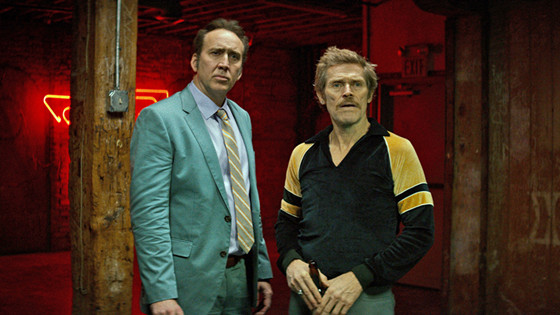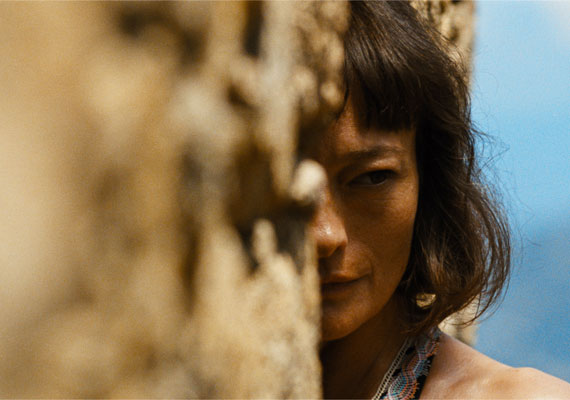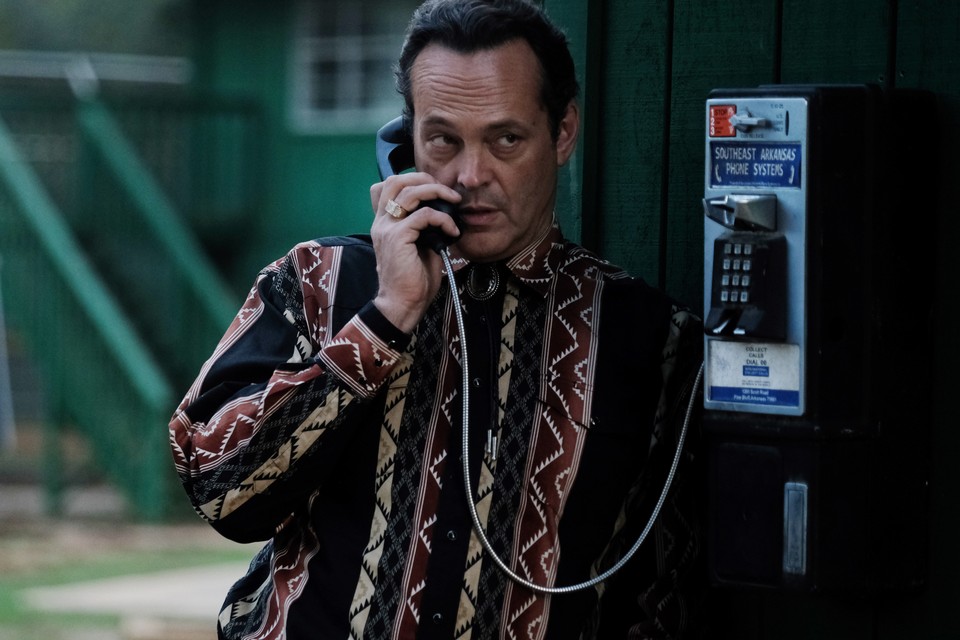6. Dom Hemingway (Richard Shepard, 2013)

Hedonistic cockney safecracker Dom Hemingway (Jude Law) is released after a 12-year incarceration. Dom reunites with his one-handed best friend Dickie Black (Richard E. Grant), then seeks reparations from his ex-boss Ivan (Demián Bichir) in the south of France. Whilst reentering London’s criminal underworld, Dom strives to reconnect with his estranged daughter Evelyn (Emilia Clarke).
In an off-piste role, Jude Law stitches Dom with laugh-out-loud humour, pertinent in his poetic monologues. Law’s perfectly paired with the urbane deadpan of Swazi thespian Richard E. Grant, in a buddy road comedy part echoing his best work in Withnail and I (1987). In addition, there’s a mob boss (Jumayn Hunter) who’s furious at Dom for killing his childhood cat, ‘Bernard.’ The first act in the picturesque south of France is the movie’s artistic highpoint. Suspense is increased through Dom outrageously insulting his villainous host, as well as the theft of his prison compensation.
The atmospheric Provençal texture is evoked through the fairytale romance of Paolina (Mădălina Diana Ghenea) singing on the villa’s florid steps by candlelight. The jet set debauchery of the cocaine pool party montage is juxtaposed against the slow-mo car crash’s abrupt, gory mutilation. Enlisting Kerry Condon (The Banshees of Inisherin), this shocking tonal polarity stirringly meditates upon the fickle transience and fragility of life. The ultimate meaninglessness of money and the importance of relationships, when seen through the hourglass of death.
Alongside the gangster adventures, Law blends transgressive comedy with a tragic has-been character study. At heart, Dom Hemingway’s a touching chamber piece about a broken widower yearning to make amends with the daughter he abandoned. The theme is brought to life by the raw honesty of Emilia Clarke’s thoughtful turn. Evocatively lit and told through a picaresque, unusually novelistic structure, Dom Hemingway’s an unsung yet fun East End gangster fable. It’s recommendable to fans of Guy Ritchie’s filmography.
7. Dog Eat Dog (Paul Schrader, 2016)

Three ex-prisoners: Troy (Nicolas Cage), Mad Dog (Willem Dafoe) and Diesel (Christopher Matthew Cook) are hired to kidnap the baby of a wealthy man. The script’s based on the novel by felon, author and Reservoir Dogs actor Edward Bunker.
Of the barrage of movies Nicolas Cage headlined in the 2010s, Dog Eat Dog is an unusually strong effort. Though disparaged upon release, in actuality, Dog Eat Dog is an impeccable, garish heist story with interesting, layered protagonists. What is more, it’s a highlight of Taxi Driver screenwriter Paul Schrader’s career, who also delivers a characterful performance.
In a grimy landscape of Cleveland’s underbelly, the screenplay protests against the contemporary situation of American police officers racially targeting and shooting African Americans. “They’ve got a licence to kill brothers nowadays,” reflects one African American character. Furthermore, Dog Eat Dog humanistically details the plight of ex-cons, portraying them as relatable and paradoxically sympathetic.
The verisimilitude of Bunker’s autobiographical writing deconstructs how prison can inculcate an individual to operate from a default of violence. It speaks of the lack of opportunities for the redemption of ex-cons. How they’re often left no choice but to revert to past mistakes and criminal camaraderie to necessitate support and survival. This is communicated through extraordinary shapeshifter Willem Dafoe’s complex character.
Underneath Mad Dog’s paranoid sociopathy and trigger happy murdering, Dafoe sculpts a tearful articulation of loneliness, trauma and sensitivity. “That’s all I ever wanted: unconditional love.” The violent Dog Eat Dog is stylistically bold and magical realist at times. It scrapbooks black-and-white and pink colour grading, suffused with a rockabilly soundtrack. The magical realism exists in aspects such as the mesmerising Cage, true to eccentric form, impersonating Humphrey Bogart for the duration of an extended scene.
8. Let the Corpses Tan (Hélène Cattet, Bruno Forzani, 2017)

A band of gold robbers are hiding out in an abandoned Mediterranean hamlet with an irritating, libertine artist (Elina Löwensohn) when they’re ambushed by the police. An epic shootout ensues.
Often, the description ‘style over substance’ is used derogatorily, but in the case of Let the Corpses tan, it is high praise. The narrative takes place in a heightened world, where a drunken author siestas in a ruined church, surrounded by leather-bound books and a taxidermy macaw. Filmed in Corsica, the movie’s a French arthouse, action, neo-western with awe-inspiring cinematography.
Revelling in gold-powdering, erotic, performance art abstraction, the impressionistic compositions rival the catalogue of a world-renowned photographer. These often venture in to daydreams, such as when a crucified, naked woman is drenched in Champagne. The camera is regularly pointed at the sweltering sun, reducing the characters to zombie-like silhouettes. Other times, disorientation is elicited through switching in and out of focus on different plains of a shot.
Like the overarching style, the opening title sequence pays homage to spaghetti westerns: moving stencils of guns dyed in block colours. Regularly, once a significant event has transpired, the timeline switches back to the past, repeating the event from another character’s perspective. Like Election, Let the Corpses Tan has been well-reviewed but needs more substantial attention from the English-speaking world.
9. Arkansas (Clark Duke, 2020)

Arkansas is an adaptation of John Brandon’s novel. Drug dealers Tyler (Liam Hemsworth) and Swin (Clark Duke) seize control of their underboss’s operation. However, their independent bravado does not sit well with their clandestine chief, the ‘Frog’ (Vince Vaughn), whom they’ve never met. The supporting cast comprises of John Malkovich, Eden Brolin, Vivica Fox and the late Michael Kenneth Williams.
A particularly accomplished facet of this Dixie mafia saga is the creative attention to detail in the unique characters. For example, Tyler is overthinking, impatient and paranoid, whereas Swin is personable and espouses a criticism of materialism. Subsequently, Arkansas is refreshing as it treats its characters like realistic individuals, rather than merely deploying stock figures to advance the story.
As well as its mastery of dramatic irony, another source of praise for Arkansas is its original plot. It’s structured over 2 flitting timelines: the 1980s and the present day. This facilitates conveying Arkansas’ theme: the recruitment and tutelage of innocent people into a life of crime. By exposing this transition, the lives of criminals are demythologised.
The audience can understand what conditions turn an ordinary person into a killer, calling into question our morality and prejudices. Akin to the talent of Malkovich and Williams, Vince Vaughn delivers one of his most superlative contemporary performances. In contrast to his comedic roles, Vaughn paints Frog with laconism, sly intelligence and menace, signifying an especial maturity at this stage of his career.
10. The Toll (Ryan Andrew Hooper, 2021)

A tollbooth operator (Michael Smiley) in Pembrokeshire, Wales is confronted with his criminal past. The motley characters include: a female Elvis impersonator (Evelyn Mok), a gang of triplet bandits (Gwyneth Keyworth), a London mobster (Gary Beadle), vigilante sheep farmers and a ukulele player (Darren Evans) who talks only in mumbles and whoops. The story is told through an embedded narrative in non-linear fashion.
Firstly, The Toll plays like a Welsh version of a Coen brothers movie. This is salient in the storyline, tone, style and the character of Catrin (Annes Elwy). As well as having the same hat, Catrin has a similar personality and function to Marge Gunderson of Fargo. Catrin’s a naïve, kindhearted cop who can’t comprehend the vice plaguing her sleepy rurale. Also like Fargo, the gangsters and neo-noir violence contrast against the humorous, bucolic folksiness of the area’s culture.
Indeed, the culture, landscape and humour of Wales is at the film’s artistic forefront, with a charming use of the Welsh language in certain instances. In parallel to its status as an engaging, stylish ‘Welsh western’ caper, The Toll is a very funny black comedy. For instance, the triplet bandits attempt to rob the toll booth, but the operator has nothing to provide but a few pennies, a £1 watch and a sandwich. The triplets steal the toll operator’s sandwich before compelling him to “follow us on Instagram.” Afterwards, the toll operator seeks revenge for his stolen sandwich.
What is more, The Toll meditates upon the grieving process, as well as extolling the glory of a tranquil, “unremarkable life.” The film did accumulate positive reviews, but it needs to be more widely viewed and discussed. It’s one of the best British films of the last decade and a peak of Welsh cinema. The outstanding Michael Smiley is rightfully given the opportunity to thrive as a leading man. Meanwhile, Elwy’s emotive, sympathetic turn distinguishes her as a major talent.